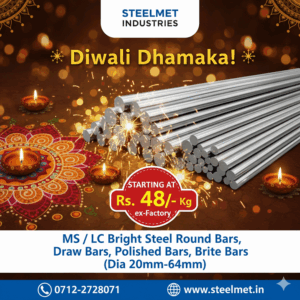When selecting between black steel bars (hot rolled) and bright steel bars (cold finished), factors like machinability, surface finish, and corrosion resistance often get attention. However, straightness is one property that directly impacts usability, machining efficiency, and final product quality.
At Steelmet Industries, we regularly encounter customers who need highly straight bars for precision machining, fasteners, automotive parts, and engineering applications. Here’s why bright bars outperform black bars in straightness, even after straightening processes.
1. Straightness in Black Bars (Hot Rolled)
Black bars are produced by hot rolling at high temperatures.
During cooling, uneven thermal contraction leads to inherent warping, bends, and twists.
Even after undergoing mechanical straightening on specialized machines, black bars retain residual stresses.
These stresses make the bars spring back slightly after straightening, preventing perfect alignment.
The rough surface and dimensional tolerances also make it harder to achieve uniform straightness across lengths.
Result: Black bars show improved but limited straightness, never matching the precision required for high-tolerance applications.
2. Straightness in Bright Bars (Cold Finished)
Bright bars are produced by cold drawing, peeling, or grinding, which inherently improves straightness and dimensional accuracy.
These processes redistribute and relieve stresses, resulting in bars with tighter straightness tolerances.
After production, bright bars undergo specialized straightening (using multi-roll or press-straightening machines).
Due to their refined microstructure and surface finish, bright bars respond better to straightening and retain their alignment.
Result: Bright bars can achieve very close straightness tolerances, meeting demanding requirements for CNC machining, fasteners, and precision components.
3. Why Black Bars Cannot Match Bright Bars in Straightness
Even with specialized equipment and fixtures, black bars will not achieve the same degree of straightness as bright bars because:
Residual Stresses – Hot rolled bars have internal stresses from uneven cooling, which reappear even after mechanical straightening.
Rough Surface & Scale – The irregular surface makes straightening less uniform compared to the smooth bright bar finish.
Dimensional Tolerances – Hot rolled bars have looser tolerances, adding variation in bending and straightening response.
Cold Finishing Advantage – Bright bars are already stress-relieved and refined during processing, allowing for superior straightening results.
4. Practical Impact for Users
Black Bars: Suitable for applications where surface finish and close straightness tolerances are not critical (construction, general fabrication).
Bright Bars: Essential for machining, automotive, and engineering applications, where straightness impacts productivity, tool wear, and final component accuracy.
✅ Conclusion – The Steelmet Advantage
While straightening can improve black bars to some extent, they cannot achieve the precision straightness of bright bars due to fundamental differences in production and stress distribution.
👉 At Steelmet Industries, our bright bars are manufactured with tight straightness tolerances, making them the preferred choice for customers who demand accuracy, efficiency, and consistency.
📞 Call to Action:
Need high-precision bright bars with superior straightness?
Contact Steelmet Industries today for customized solutions in rounds, squares, hexagons, flats, and special profiles.


